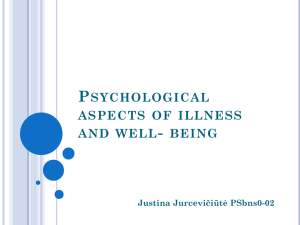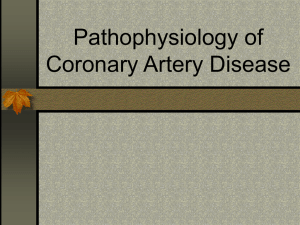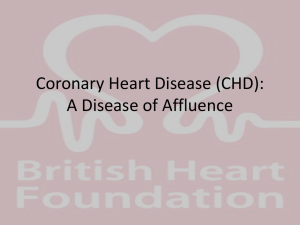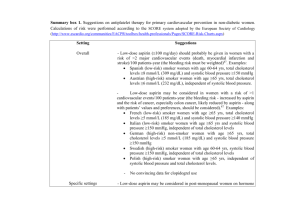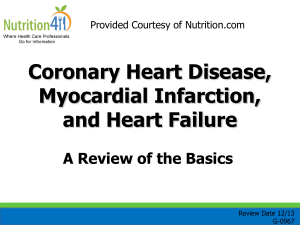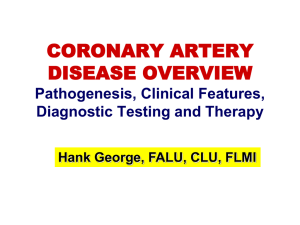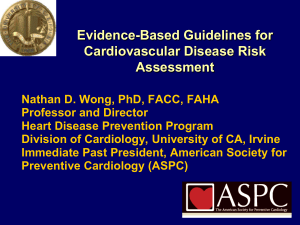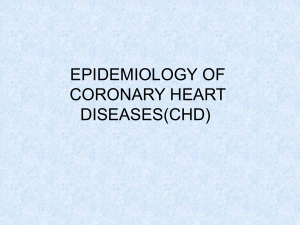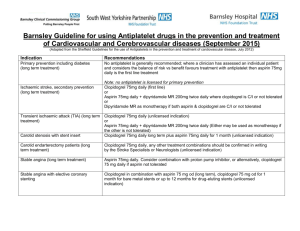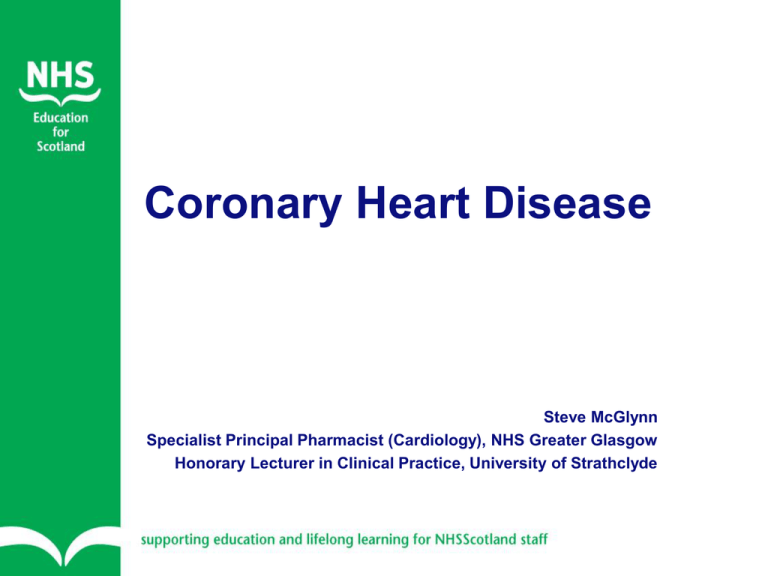
Coronary Heart Disease
Steve McGlynn
Specialist Principal Pharmacist (Cardiology), NHS Greater Glasgow
Honorary Lecturer in Clinical Practice, University of Strathclyde
Presentation content
What is CHD
What causes CHD
How common is CHD
How to we treat CHD
Why do we treat CHD
How should we care for patients with CHD
CHD: a definition
Coronary heart disease (or coronary artery
disease) is a narrowing of the small blood
vessels that supply blood and oxygen to the
heart (coronary arteries).
Coronary disease usually results from the build
up of fatty material and plaque (atherosclerosis).
As the coronary arteries narrow, the flow of
blood to the heart can slow or stop. The disease
can cause chest pain (stable angina), shortness
of breath, heart attack (myocardial infarction), or
other symptoms.
Coronary Heart Disease
Stable angina
Silent ischaemia
Syndrome X
Prinzmetal’s angina (vasospasm)
Acute coronary syndromes (ACS)
Unstable angina
Non-ST segment elevation myocardial infarction
(NSTEMI)
ST segment myocardial infarction (STEMI)
Risk Factors
Modifiable
Hypertension
Diabetes
Hypercholesterolaemia (Total : HDL-C, LDL-C)
Smoking
Non-modifiable
Age
Sex
Family history
Incidence (per 100,000)
700
600
N.Ireland
Scotland
Ireland
Eng&Wales
Germany
Italy
Greece
France
500
400
300
200
100
0
Male
Female
National Problem
CHD/Stroke Task Force Report:
Estimated half million people with CHD
180,000 with symptomatic disease
12,500 deaths from CHD
‘Towards A Healthier Scotland’:
Reduce death rates from heart disease in people
under 75 years by 50% between 1995 and 2010
Diagnosis
History
Symptoms
Physical signs
Investigations
ECG (often normal)
Exercise testing (diagnostic and prognostic)
Angiography (guides management)
Symptoms
Chest pain
Causes
Exercise, stress, emotion especially if cold, after a
meal
Description (watch how patient describes pain)
Crushing, pressure, tight, heavy, ache
Location
Left chest, shoulder
Radiation
Arm, neck, jaw, back
Relieved by rest and/or GTN
Breathlessness
Syncope (rare)
Diagnosis
History
Symptoms
Physical signs
Investigations
ECG (often normal)
Exercise testing (diagnostic and prognostic)
Angiography (guides management)
Exercise stress testing
Diagnosis
History
Symptoms
Physical signs
Investigations
ECG (often normal)
Exercise testing (diagnostic and prognostic)
Angiography (guides management)
Angiography
Management
Risk factor reduction
Smoking
NRT
Exercise
Diet
Hypertension
Diabetes
Drug therapy
Coronary intervention
and surgery
Angioplasty stent
(PTCA)
Coronary Artery Bypass
Grafts (CABG)
Drug Therapy
Aims of therapy
Prevent disease progression (secondary prevention)
Control symptoms
Options
Secondary prevention
Antiplatelets
Statins
-blockers
ACE inhibitors
Symptom control
-blockers
Calcium antagonists
Nitrates (short and long acting)
Potassium channel openers (nicorandil)
If channel inhibition (ivabradine)
Ranolazine
Antiplatelets
Aspirin
Clopidogrel
Prasugrel
Ticagrelor
Antiplatelets:
Aspirin and clopidogrel
Aspirin monotherapy for all patients unless contra-indicated
Clopidogrel if:
Allergy or GI bleeding
Aspirin intolerant (try PPI first)
Aspirin sensitive
Previous ACS (dual antiplatelet therapy)
Previous PCI (dual antiplatelet therapy)
Both usually 75mg daily (sometimes aspirin 150mg)
Monitor for side effects (GI)
Probably life-long treatment
Clopidogrel duration depends on reason
Antiplatelets:
prasugrel and ticagrelor
Approved by SMC
Place in therapy not clear
May be alternative to clopidogrel as part of dual
antiplatelet therapy
Some benefits over clopidogrel
Much more expensive
Side effects may be a problem
Prasugrel: more cerebral haemorrhage
Ticagrelor: can cause breathlessness
Statins
All patients unless contra-indicated
Active liver disease
Different dosing strategies
Target TC<5mmol/L or LDL-C<3mmol/L
Dose to effect
Aggressive TC reduction (even if <5mmol/L)
E.g. Simvastatin 40mg daily
Very aggressive TC reduction (?ACS only)
E.g. Atorvastatin 80mg daily
Monitoring
Effectiveness
Lipid profile
Toxicity
Symptoms of myopathy
Markers for myopathy (creatine kinase) if
symptoms
Liver function tests (AST/ALT)
Baseline and during treatment
Especially high dose statins
Probable lifelong treatment
-Blockers
No direct evidence of benefit in stable CHD
Extrapolation from post-MI data
Protective effect and symptom control
All patients unless contraindicated
Asthma (reversible airways obstruction)
Severe peripheral vascular disease
Heart block / bradycardia
Hypotension
Dose depends on effect (no specific dose)
Avoid sudden withdrawal if possible
Monitoring
Effectiveness
Heart rate (50-60 bpm if tolerated)
Blood pressure
Toxicity
Side effects (often overemphasised)
Cold extremities
Nightmares
Fatigue (especially on initiation)
Wheeze
Impotence
ACE Inhibitors
Conflicting evidence in stable CHD
For: Ramipril & perindopril
Against: Trandolopril
Little evidence in uncomplicated angina patients
Most studies involve a large proportion of post-MI
patients
Indicated if high risk patient, e.g.:
Post-MI
Heart failure
Diabetes
Up-titrate treatment to target dose
Monitor treatment before and at the start and end of up-titration
Target doses:
Ramipril 10mg daily
Perindopril 8mg daily
Other ACE inhibitors ???
Monitoring
Effectiveness
Blood pressure
Toxicity
Side effects
Cough
Hyperkalaemia
Renal dysfunction
Calcium antagonists
Some extrapolated evidence of protective effects from
post-MI studies for rate limiting drugs (verapamil /
diltiazem)
Alternative rate control therapy if -Blocker contra-indicated
or not tolerated
Demonstrated benefit for symptom control for all calcium
antagonists
Avoid short acting formulations
Monitor for effect (symptoms and blood pressure) and
side effects
Nitrates
Sublingual GTN for all patients
Education crucial
Long-acting nitrates useful for symptom control
Controlled-release formulations expensive but may
improve adherence
Dose to effect and to avoid tolerance developing
Monitor for effect (symptoms) and side effects
Nicorandil
Some evidence that symptom control translates to
fewer admissions
In combination with standard treatment
Monitor for effect and side effects
Ivabradine*
No published evidence on benefit beyond symptom
control
Possible alternative to beta-blockers (or rate-limiting
calcium antagonists) for rate control if contraindicated.
May cause visual disturbance (phosphenes) due to
retinal side-effects
Cytochrome P450 3A4 drug interactions
9th October 2006: The Scottish Medicines Consortium has advised that ivabradine is not recommended for use
within NHS Scotland as the economic case had not been demonstrated.
Possible treatment regimen
Secondary prevention
Aspirin 75 daily (or clopidogrel 75mg daily)
Simvastatin 40mg daily
-Blocker (or rate limiting calcium antagonist) dosed to
heart rate
ACE inhibitor to target dose if high risk
Symptom control
GTN Spray as required.
-Blocker (or rate limiting calcium antagonist) dosed
to heart rate.
Chose any one from the three alternatives (avoid
combining -Blocker and rate limiting calcium
antagonist.
Coronary intervention (PCI)
Patients should be considered for PCI, especially if
uncontrolled or high risk)
Angiography to determine best option:
Medical management
Angioplasty / coronary stent
Combination antiplatelets post-PCI
Duration depends on presentation and
intervention
Coronary artery bypass grafts
Angiography
Stent deployment
Stent deployment
Restoration of flow
Drug interactions (general)
All angina medication (except statins/aspirin) lower blood
pressure
Caution using angina medication with other drugs that
lower blood pressure
Avoid other drugs that cause GI irritation
Avoid using two drugs that reduce heart rate if possible
Drug interactions (specific)
See appendix 1 of BNF for full list
Aspirin and other NSAIDs
Simvastatin* and e.g. verapamil, amiodarone
Simvastatin* and grapefruit juice
Calcium antagonists and digoxin
ACE inhibitors and NSAIDs
ACE inhibitors and K+
GTN (tablets) and drugs causing dry mouth
Nitrates and e.g. sildenafil (Viagra)
* Probably also applies to atorvastatin
Drugs to avoid if possible
Sildenafil and related drugs
NSAIDs especially COX 2s (inc. aspirin at
analgesic doses)
Sympathomimetics (e.g. decongestants)
Caffeine (high doses)
Salt substitutes or K+ unless indicated (ACEI)
Herbal medicines (unless known to be safe)
Medication adherence
Compliance with prescribed medication is
approximately 50% in chronic diseases.
Some patients are wilful non-compliers
(Concordance)
Different methods of ‘measuring’ compliance.
Options available to improve compliance e.g.
Routine, reminders, aids, once/twice daily
regimens.
Pharmaceutical care
Education on lifestyle modification
Smoking, Diet, Alcohol, Exercise
Support for lifestyle modification
NRT, Diet
Selection of evidence based therapy
Secondary prevention
Aspirin, beta-blockers, statins, ACE inhibitors
Pharmaceutical care 2
Assessment for appropriate treatment
Symptom control
-blocker, calcium antagonist, nitrate, nicorandil
Co-morbidities, contra-indications etc
Monitoring of treatment
Symptoms, side effects, biochemistry etc
Education on medication
Regimen, rationale, side effects, benefits, lack of
obvious benefit, adherence
Summary
Range of drugs available for use in CHD
Evidence to support choice of some treatments
Monitoring of treatment important
Adherence may be a problem



